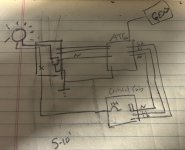sparkles97
Member
- Location
- Washington
At what distance or amperage does inductive heating and impedance start to become an issue for ungrounded conductors ran without their respective grounded or ungrounded conductor in the same raceway? As an apprentice, I was told that short at distances and low amperage inductive heating and impedance increasing are not an issue (Less than 10', a few 20a circuits). From my own research, that seems to be the case for short distances and very small loads but what is the threshold or formula to determine when it becomes a safety hazard? I understand this violates 300.3(b), this is a question to gain a better understanding of some of the principals at play.
An example I can use to show a real life scenario in relation to the question would be a critical load subpanel with a transfer switch less than 10' away. Critical load panel serves receptacles, lighting, fridge/freezer, etc. Ungrounded conductors wire nutted in the MSP and ran in a metallic raceway to the critical load subpanel. Neutrals for the respective circuits remain landed in the MSP. I've attached a professional engineered to scale drawing
For reference: Single phase 120v/240v 60HZ.
An example I can use to show a real life scenario in relation to the question would be a critical load subpanel with a transfer switch less than 10' away. Critical load panel serves receptacles, lighting, fridge/freezer, etc. Ungrounded conductors wire nutted in the MSP and ran in a metallic raceway to the critical load subpanel. Neutrals for the respective circuits remain landed in the MSP. I've attached a professional engineered to scale drawing
For reference: Single phase 120v/240v 60HZ.


